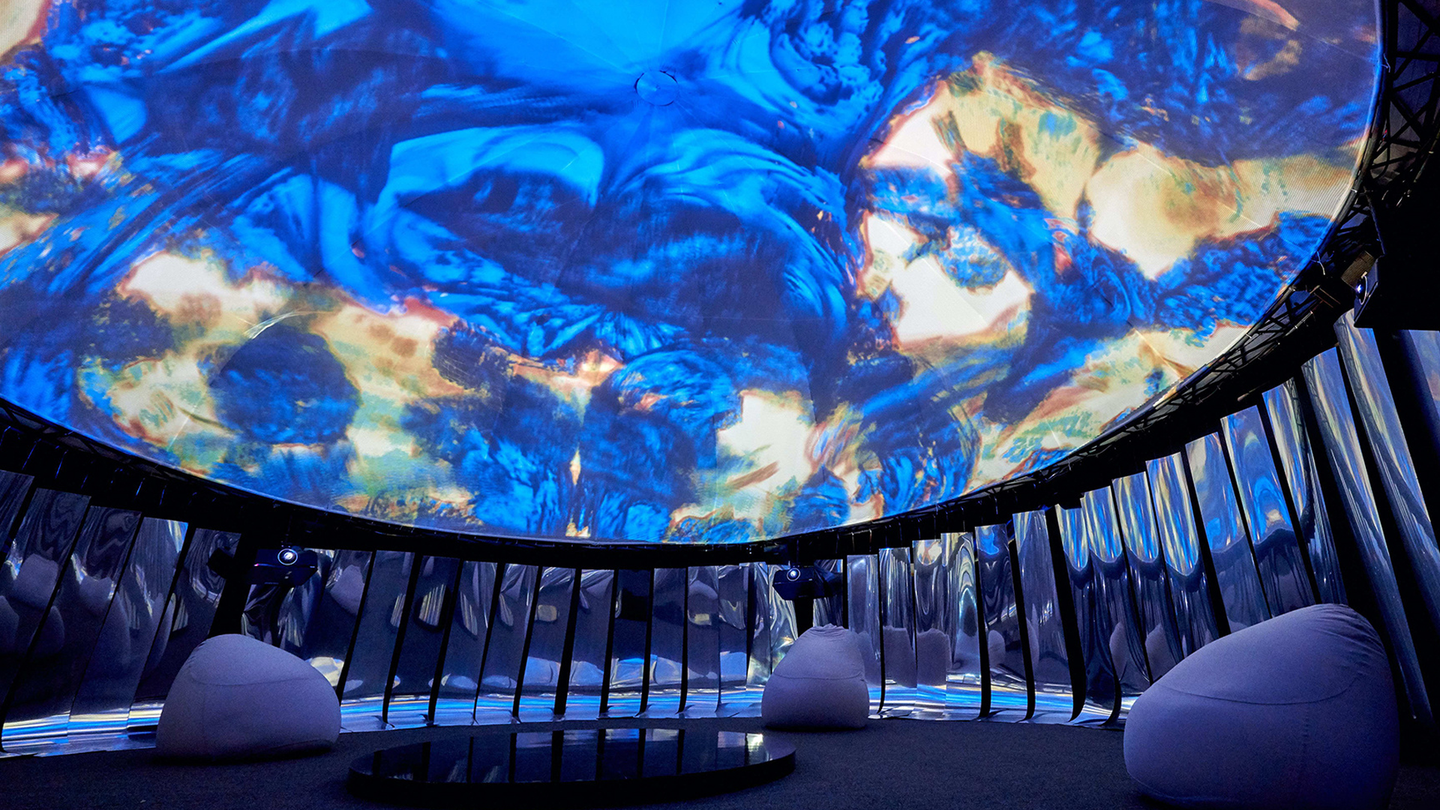Solution
solution
Holographic Bowl Projection
 Common CAVE immersive space projection is a tri-fold screen, quad-fold screen and other right-angled, right-angled CAVE edge hard splicing traces of obvious, visible to the naked eye picture caused by the cut, the visual angle there is always a little flaw, and rounded U curtain (bowl curtain) to avoid this problem, it eliminates the hard splicing, bringing visual integrity and smoothness, no loss of the rules of modeling so that it has a more unique visual effect, just as if Being in it, up and down, left and right of all angles of the screen are "wrapped" all the audience's field of vision, so that people seem to be in the realm.
Common CAVE immersive space projection is a tri-fold screen, quad-fold screen and other right-angled, right-angled CAVE edge hard splicing traces of obvious, visible to the naked eye picture caused by the cut, the visual angle there is always a little flaw, and rounded U curtain (bowl curtain) to avoid this problem, it eliminates the hard splicing, bringing visual integrity and smoothness, no loss of the rules of modeling so that it has a more unique visual effect, just as if Being in it, up and down, left and right of all angles of the screen are "wrapped" all the audience's field of vision, so that people seem to be in the realm.
U-screen (bowl screen) projection fusion principle
U curtain (bowl curtain) correction is difficult because of its rounded corners of the geometric correction of all the curve correction, each straight line of each point should be accurately calibrated and aligned, the uniformity and accuracy of the grid directly determines the quality of the final picture, the design of the design of the difficulty is very large, need to take into account the overall uniformity of the picture and rounded corners of the fusion of the brightness of the band is the same.
I. System architecture design
Hardware Configuration:
Projection equipment: recommended engineering projector single brightness ≥ 10,000 lumens, resolution ≥ 2K (1920 × 1200), support edge fusion and HDR display.
Quantity Configuration: 14-24 projectors according to the diameter of the bowl screen (usually 8-16 meters), the bowl wall and the bottom of the bowl projected in separate areas.
Screen material: sound transmission microporous aluminum plate (gain value 0.8-1.2, reflection uniformity ≥ 90%), splicing gap ≤ 0.5mm, support acoustic transmittance (frequency range 20Hz-20kHz).
Steel structure frame: no welding assembly, anti-deformation design, adaptable to the curvature radius of 3-5 meters of the bowl curtain modeling1
Core Equipment: Converged Server: Equipped with NVIDIA Quadro RTX A6000 graphics card, supporting 4K real-time rendering and multi-channel synchronization.
Control terminal: Centralized centralized control system (e.g. Crestron/AMX) with integrated touch panel and wireless remote control.
Fusion Software Configuration:
Geometric correction: Polar coordinate geometric correction: Pixel-level alignment of bowl wall curves by meshing (40×40 dot matrix) to eliminate surface distortion.
Perspective Correction: Automatically matches the projector's optical axis based on 3D point cloud data to ensure a distortion-free picture (e.g., trapezoidal correction for top-down view at the bottom of a bowl).
Color Management: Dynamic Color Gamut Mapping: Automatically adjusts multi-camera luminance difference (≤10%) and color temperature consistency (ΔE≤1.5), supports sRGB 99% color gamut coverage.
Content Engine: Immersive Media Server: Supports 3D stereoscopic content playback, GIS data overlay, and real-time video stream processing (e.g. drone aerial footage access).
interactive layer
Support touch, body, voice interaction, integrated SDK interface (Unity/Unreal Engine), can develop customized interaction logic (such as gesture control scene switching).
Curve Fusion Algorithm
Adaptive mesh deformation technique is used to nonlinearly map the bowl wall surface to solve the hard splicing problem of traditional right-angle fusion.
Fusion band width control: Through the edge feathering (Feather) and luminance compensation algorithm, make the fusion band luminance difference ≤ 5%.
Multi-device synchronization
Based on Genlock signal synchronization and time code alignment, it ensures that the frame synchronization error of multiple projectors is ≤2ms to avoid picture tearing.
synchronization
The sound system is aligned with the projection screen via the AES67 protocol and supports Dolby Atmos positioning (error ≤ 10ms).
Site survey and modeling
A laser scanner was used to acquire 3D point cloud data of the site and generate a CAD model of the bowl curtain surface.
Determine the projector lifting position (boom spacing ≤ 1.5 meters) and calculate the optimal projection angle and focal length.
Equipment installation and commissioning
Projector calibration: use laser markers to mark the boundaries of the projection area, collect the edge point cloud through the camera, and automatically generate calibration parameters3
The
Color calibration: A spectrophotometer (e.g. X-Rite i1Pro 3) is used to measure each projector's color parameters and unify the color gamut through software.
Content production and deployment
3D material development: modeling using Blender or Cinema 4D, adapting bowl screen curvature (resolution ≥ 8K, horizontal pixels = number of projectors x single resolution).
Typical Application Scenarios
Exhibition Halls and Science and Technology Museums
It is used to display urban planning, history and culture, etc. Through the combination of dynamic images and data modeling, it enhances the sense of audience participation.
Business & Cultural Tourism Experience
Create immersive experience spaces, such as virtual travel and sci-fi scene simulation, combined with interactive features to realize real-time interaction between the audience and the content.
Corporate Communications & Launches
Present brand story or product information through naked eye 3D effect to enhance visual impact.
 outstanding talent
outstanding talent

